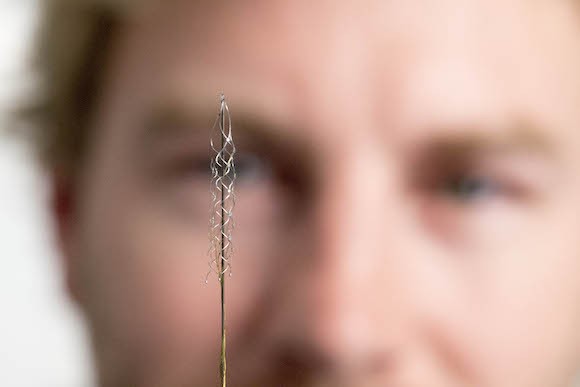
In 1973 at the University of California, Los Angeles, computer scientist Jacques Vidal observed the brain signals of a research patient and posed the question: “Can these observable electrical brain signals be put to work as carriers of information in man-computer communication or for the purpose of controlling such external apparatus as prosthetic devices?” 43 years later in the established world of neuroscience, researchers at the University of Melbourne have developed a minimally-invasive electrode implant that does just that, recording high-quality neural signals from the brain’s motor cortex. Having successfully translated these neural signals into movement commands for control for bionic prosthetics in exoskeletons in pre-clinical trials, the brain-machine interface can, hypothetically, be adapted for discernible control over a variety of computer systems.
The paperclip-size device operates through the use of a stentrode, or stent-based electrode, which is implanted within a blood vessel next to the brain. Essentially, the device records brain activity and converts the acquired signals into electrical commands. By bypassing the natural connections of damaged neurons—such as in the case of a spinal cord injury—the implanted device act as a bionic spinal cord, signaling movement of the limbs directly from the device to the assistant bionic system. Surgically remapping the remaining nerves of physically handicapped individuals allows the new brain-machine interface to successfully facilitate the thought-controlled movement of bionic limbs and exoskeletons.
Using stent technology, the team at Melbourne can implant the small device into a blood vessel near the brain in a quick and simple procedure, minimizing the invasive nature of high-risk open brain surgery while still attaining high-quality brain signals. “Our electrode array self-expands to stick to the inside wall of a vein, enabling us to record local brain activity,” Dr. Nicholas Opie, a biomedical engineer at the University of Melbourne said in a press release . “By extracting the recorded neural signals, we can use these as commands to control wheelchairs, exoskeletons, prosthetic limbs or computers.”
By 2017, the team hopes to implant the device in humans with complete paralysis to help return the function and mobility of patients with the assistance of exoskeletons. If the human trials are successful, the device could eventually be used as a method of controlling computers through thought. Furthermore, the minimally-invasive implant could potentially allow for safer research into the field of though-controlled devices without the many dangers associated with major surgical operations on the brain.
Sources: Melbourne , PM , The Scientist
Advertisement
Learn more about Electronic Products Digital





